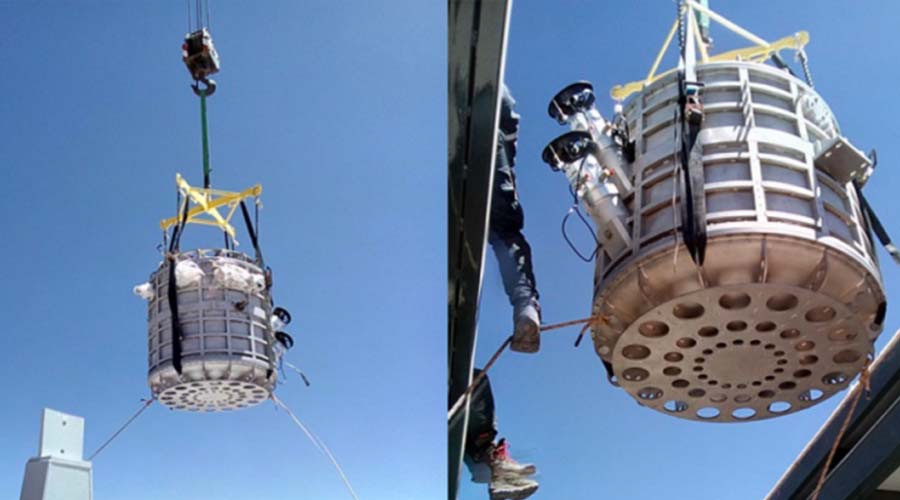 The QUBIC (Q&U Bolometric Interferometer for Cosmology) telescope, an innovative instrument that will observe the cosmic microwave background, the residual echo of the big bang, from a high-altitude (5,000 metres) desert site in the Argentine Andes near San Antonio de Los Cobres, was inaugurated in Argentina on 23 November. The project sees Italy as leader thanks to its scientific and technological contributions provided by INFN and the Universities of Milan, Milan Bicocca, Rome Tor Vergata and Rome Sapienza.
The QUBIC (Q&U Bolometric Interferometer for Cosmology) telescope, an innovative instrument that will observe the cosmic microwave background, the residual echo of the big bang, from a high-altitude (5,000 metres) desert site in the Argentine Andes near San Antonio de Los Cobres, was inaugurated in Argentina on 23 November. The project sees Italy as leader thanks to its scientific and technological contributions provided by INFN and the Universities of Milan, Milan Bicocca, Rome Tor Vergata and Rome Sapienza.
QUBIC will focus on measuring the signal produced by the interaction of primordial gravitational waves with the electromagnetic radiation that permeates the universe. After its development and integration in the European laboratories of the universities and research bodies involved in the collaboration, QUBIC arrived in Argentina, in the city of Salta, in July 2021, where the calibration and laboratory testing took place. The results of these activities are provided in eight papers that appeared in the Journal of Cosmology and Astroparticle Physics in April this year, and confirmed the proper functioning of the instrument and the bolometric interferometry, i.e., the newly developed technique on which QUBIC's observations will be based, which combines the very high sensitivity of bolometric detectors cooled to near absolute zero (-273 °C) with the precision of interferometric instruments. The goal of observing the very weak polarisation effects in the microwaves that originated in the very early stages of the expansion of the universe after the big bang, i.e. the direction in which the associated electromagnetic field oscillates as it propagates, made it necessary to develop and build a complex and unique instrument. The measurement of such a weak signal will be considered free from systematic error only if there are consistent results from very different instruments, which is why QUBIC, the only bolometric interferometer, is an irreplaceable resource in the study of the first moments of life of the universe. Thanks to its multispectral and self-calibration capabilities, QUBIC will produce data that is entirely original and complementary to that of other experiments, providing researchers with countless possibilities for cross-checking and thus unparalleled robustness of results.
The effectiveness of QUBIC and the measurement method used to study the primordial universe were verified by the collaboration during the long period between the first tests conducted at the APC - Astroparticule et Cosmologie - laboratory in Paris, and the arrival of the instrument in Argentina, at the laboratory in Salta, where the first celestial observations were made. The installation of the experiment at San Antonio de Los Cobres which took place in October, thus marks a success that comes at the end of a long period of preparation and, thanks to the extraordinary transparency and stability of the observation site's atmosphere, will allow ultrasensitive measurements to begin.
The first measurements should demonstrate the effectiveness of bolometric interferometry in observing astronomical sources. Approximately one year from now, the instrument will be made even more competitive by increasing the number of antennas and detectors, so as to be able to perform measurements of cosmological interest within three years.
The Italian contribution was crucial to the development of the instrument, and will continue to be so in the later stages of the experiment. The instrument is housed in a cryostat, built in the laboratories of Sapienza and the INFN Division in Rome, capable of cooling near to absolute zero not only the detectors but also the interferometer's entire optical system. The same group also built the cryo-mechanical system that measures the state of polarisation of the radiation. Other cryogenic components, which operate at a temperature below -270°C, are also Italian, like the highly advanced corrugated antennas that collect the radiation from the sky, built in the laboratories of the University of Milan and the INFN Division of Milan. The optics that focus it on the detectors and the shutter system that varies the configuration of the interferometer, and its self-calibration were built by the University and INFN Division of Milan-Bicocca. QUBIC is the result of the collaboration of 130 researchers, engineers, and technicians in France, Italy, Argentina, Ireland, and the UK.




